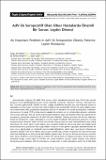Please use this identifier to cite or link to this item:
http://hdl.handle.net/11547/11679| Title: | An Important Problem in AdV-36 Seropositive Obesity Patients: Leptin Resistance |
| Authors: | Altinok, Ozge |
| Issue Date: | 2023 |
| Abstract: | Adenoviruses are naked viruses with an icosahedral nucleocapsid containing a 36 kb linear double-stranded DNA genome that encodes 30-40 proteins. The word "obesity" in Latin means "because of feeding". Obesity is an energy metabolism pathology that paves the way for physical and psychological problems with excessive fat accumulation that can impair health. Body mass index (BMI), unaffected by gender and age, is the most useful indicator of overweight and obesity at the population level. The concept of infectobesity was first introduced in 1978 after the data showed that viruses might also play a role in obesity cases. In the same year, adenovirus 36 (AdV-36) was isolated from the stool of a six-year-old girl with diabetes who was admitted to the hospital with the complaint of enteritis. One of the adipokines important for obesity is leptin. Leptin regulates food intake and energy metabolism by having a "negative feedback" effect on the hypothalamus. Leptin acts as a sensor that acutely regulates energy metabolism by creating hunger and satiety signals and it also regulates the amount of body fat and the required weight of the person by adjusting its concentration in the plasma according to the nutritional status. Changes in body weight and metabolic status are often associated with acute or chronic inflammatory processes. Human cells infected by AdV-36 showed greater differentiation and higher lipid accumulation than uninfected control cells, which increases the prevalence of obesity. There are two fractions of serum leptin, protein-bound and free form. The balance between these two fractions depends on serum leptin and soluble leptin receptor (sLR) plasma concentration, which is adversely affected by BMI. AdV-36 in- fection reduces norepinephrine and leptin levels. These two effects contribute to obesity by increasing appetite and food intake. In this study, it was aimed to determine the presence of immunoglobulin G against AdV-36 in the blood serum of obesity patients (BMI >= 30) and healthy weight individuals (18.5 <= BMI <= 25), and also aimed to determine and compare the leptin and soluble leptin receptor levels of these individuals. In this study, 10 ml of blood was collected on an empty stomach from obese individuals (n= 101; BMI >= 30) and healthy individuals (n= 96; 18.5 <= BMI <= 25) between the ages of 18-55. All participants consisted of who were not taking any medication and were not immunosuppressed. Blood samples separated into their serum were analyzed for AdV-36 IgG, leptin, and soluble leptin receptor levels. Mean, standard deviation, and percentage values were calculated by descriptive statistical analysis. The data with normal distribution were evaluated with the paired and independent sample t-test and data with abnormal distribution were evaluated with the paired and independent sample Mann-Whitney U test. Findings with a p-value less than 0.05 were considered statistically significant. In conclusion, leptin levels in obese individuals who were not infected with Adv-36 were found to be low, in line with the principle that "insufficient leptin synthesis has a role in the pathophysiology of obesity". When AdV-36 infection is added to the obesity picture, it may be due to the fact that it increases leptin synthesis in patients and the level of soluble leptin receptors increases in response to the increased leptin level, that AdV-36 suppresses the binding of the leptin molecule to its receptor, which leads to leptin resistance |
| URI: | http://hdl.handle.net/11547/11679 |
| ISSN: | 0374-9096 |
| Appears in Collections: | Web Of Science |
Files in This Item:
| File | Description | Size | Format | |
|---|---|---|---|---|
| 568-579 Ozge Altinok (1).pdf | 493.76 kB | Adobe PDF |  View/Open |
Items in DSpace are protected by copyright, with all rights reserved, unless otherwise indicated.
